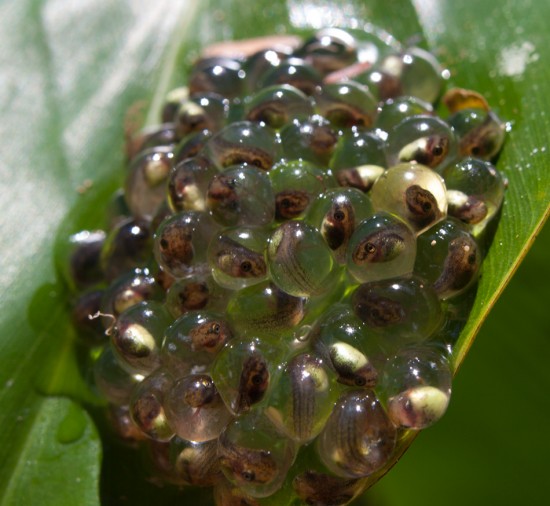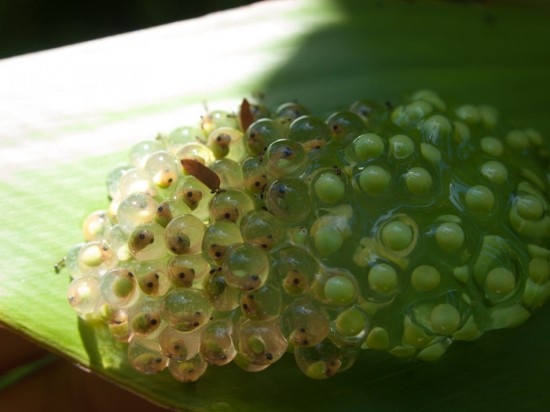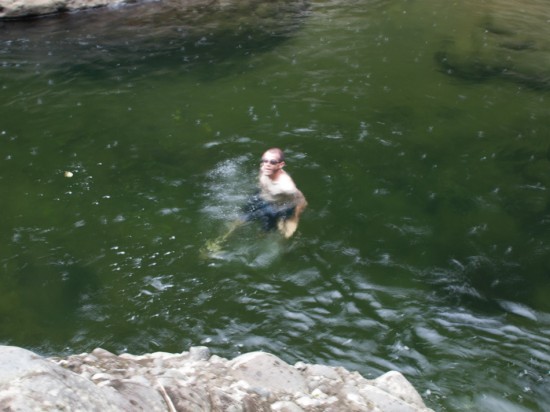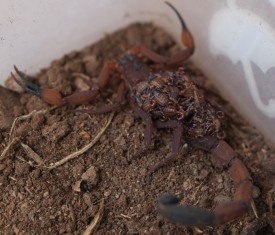Dendrobates aurotus in Valle de Las Estrella.
At the edge of some bambu on Boa’s property (between 5 and 10 acres), there is a good number of herps, including this guy. We also encountered a tropical night lizard.
Dendrobates aurotus in Valle de Las Estrella.
At the edge of some bambu on Boa’s property (between 5 and 10 acres), there is a good number of herps, including this guy. We also encountered a tropical night lizard.
I may have found an ID for the peculiar shrimp in Río Hitoy from this paper.
Outside Boa’s home, a male Agalychnis callidryas has set up territory in an ornamental plant hanging over a swimming pool. It calls each evening and is regularly successful in procuring some eggs. Here’s a few photos of him and his fertilized eggs. The development of the tadpoles are in various stages – once the tadpoles use up all the yolk in their eggs, they will escape the egg and fall into the pool below the leaf that they are attached to. Unfortunately, there is no water in the pool, but Boa try to rear them in buckets around the house (inadvertently breeding mosquitoes too…). Ants also prey on the developing eggs too.


The river at Reserva Biologica Hitoy Cerere is clear and stunningly beautiful. Hiking up the river, I observed several species of fish, spiders, and an interesting crustacean. On the way back, I swam and watched some of the fish investigate me and the disturbance I created. There were several species, but I could only ID to family: characids, cichlids, poeciliids, and eleotrids. Some of the cichlids were rearing young – the adults protected a small school of fry. Additionally, some of the eleotrid (guavinas) males were in breeding color – stunning bright blue.
As I observed some fish in a deep pool, it began to rain and Boa took some photos… it was a bit dark and my camera wasn’t set properly, so the photos are blurry… I’ll just have to go back to get some better photographs.

A mother Strawberry Poison Dart Frog (Oophaga pumilio) transports her young around on her back. It appear that she was dipping one of her tadpoles in the phytotank (reservoir of water captured between leaves of a plant) of this bromeliad. Their genus means egg eater, which comes from the maternal behavior of feeding unfertilized eggs to the tadpoles. It’s the first time I observed an adult carrying its young!
In Río Hitoy, there is a peculiar shrimp. It seems to inhabit cobble-dominated, high current velocity, areas of the river. I don’t know what it is or what it does, but it’s chelae are modified into large, hook-like structures.
UPDATE: I found a paper describing shrimp found in Boca Del Toro, Panama, which is pretty close to Hitoy. I had asked a friend, Bernald, which family of tropical shrimp may not have chelae (pinchers), and he suggested Atyidae. The paper describes Atyids, including Atya scabra, which is widely distributed (Aftrica to Panama) and looks similar to this species… so, we’ll call it Atya scabra…
| One of Boa’s many projects is to raise field-collected Centruroides sp. and create a large terrarium at this house, where he can shine a black light on them (chemicals in scorpion exoskeletons fluoresce under UV light) and wow some tourists. He’s had two successfully reproducing females. Here’s the latest batch; all of the babies are still attached to the mother. The juveniles of the other (not pictured) have begun to explore on their own. |  |